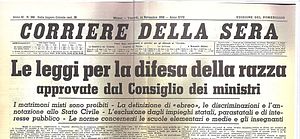
Racism in Italy refers to the existence of antagonistic relationships between Italians and other populations of different ethnicities which has existed throughout the country's history.
These ideas, albeit already common in relation to the internal affairs of the country, were first directed outwardly when the Kingdom of Italy began invading and colonizing various African countries with the purpose to build a colonial empire between the late 19th and early 20th centuries,[3][4] although policies regarding "miscegenated" children (meticci) were unclear and confusing.[5] Under Benito Mussolini's Fascist regime (1922–1943) were enacted a set of anti-Semitic laws,[1][2] as well as laws prohibiting internal migration under certain circumstances,[6] shortly after the consolidation of the political and military alliance between Fascist Italy and Nazi Germany. In the aftermath of Mussolini's fall from power, the Badoglio government suppressed the Racial Laws in the Kingdom of Italy. They remained enforced and were made more severe in the territories ruled by the Italian Social Republic (1943–1945) until the end of the Second World War.[2]
The post-war migration from southern Italy towards the more industrialized northern regions engendered a degree of diffidence across the Italian social strata. A successive wave of immigration by extracomunitari (non-EU immigrants; the word has strong undertones of rejection)[7] from the late 1980s, gave rise to political movements, such as the Lega Nord, hostile to both the so-called terroni (an Italian slur against southern Italians)[8] and clandestini (illegal immigrants: this word also has a strongly negative connotation of secrecy and criminal behavior)[9] from outside of Western Europe and the areas south of the Mediterranean.[10][11]
In 2011, a report by Human Rights Watch pointed to growing indications of a rise in xenophobia within the Italian society.[12][13] A 2017 Pew Research Center survey indicated Italy as the most racist country in western Europe.[14] A 2019 survey by Sgw revealed that 55% of the Italian interviewees justified the perpetration of racist acts.[15] On the occasion of a European Parliament resolution to condemn structural racism and racially motivated violence in 2020, around half of the Italian members voted against it.[16] According to a 2020 YouGov opinion polling, the Italian interviewees claimed that the second most common cause of discrimination practiced in the country lie with racist prejudices.[17] A 2020 Eurispes report revealed that 15.6% of Italians contend that the Holocaust never happened, and that 23.9% of the population adhere to the anti-Semitic conspiracy theories which claim that Jews control their economy.[18]
- ^ a b Shinn, Christopher A. (2019) [2016]. "Inside the Italian Empire: Colonial Africa, Race Wars, and the 'Southern Question'". In Kirkland, Ewan (ed.). Shades of Whiteness. Leiden; Boston: Brill Publishers. pp. 35–51. doi:10.1163/9781848883833_005. ISBN 978-1-84888-383-3. S2CID 201401541.
- ^ a b c Gentile, Emilio (2004). "Fascism in Power: The Totalitarian Experiment". In Griffin, Roger; Feldman, Matthew (eds.). Fascism: Critical Concepts in Political Science. Vol. IV (1st ed.). London and New York: Routledge. pp. 44–45. ISBN 9780415290159.
- ^ McLean, Eden K. (2018). "Part 4. Ensuring the Empire's Immortality, 1938–40 – Chapter 7: Enforcing the Racial Ideal". Mussolini's Children: Race and Elementary Education in Fascist Italy. Lincoln, Nebraska: University of Nebraska Press. pp. 181–202. doi:10.2307/j.ctv19x4pm.14. ISBN 978-1-4962-0722-7.
- ^ Negash, Tekeste (1997). "Introduction: The legacy of Italian colonialism". Eritrea and Ethiopia: The Federal Experience. Uppsala: Nordiska Afrikainstitutet. pp. 13–17. ISBN 978-91-7106-406-6. OCLC 1122565258.
- ^ Giulia Barrera, 'Patrilinearity, Race and Identity: The Upbringing of Italo-Eriteans during Italian Colonialism', in R. Ben-Ghiat, M. Fuller (eds.), Italian Colonialism, Palgrave Macmillan, (2005) 2016 ISBN 978-1-403-98158-5. pp. 97-108, pp. 97f.
- ^ Foot p.42.
- ^ Alexander p.57.
- ^ Dickie, J. (1999). Darkest Italy: The nation and stereotypes of the Mezzogiorno, 1860-1900. London: Palgrave MacMillan. p. 145.
- ^ Grazia Naletto (2013). "Clandestino, Lingua italiana".
- ^ Russo Bullaro, Grace (2010). From Terrone to Extracomunitario: Shifting Demographics and Changing Images in a Multi-cultural Globalized Society. Troubador Publishing. p. xxff. ISBN 9781848761766.
- ^ Dickie, J. (1999). Darkest Italy: The nation and stereotypes of the Mezzogiorno, 1860-1900. London: Palgrave MacMillan. pp. 144–146.
- ^ Melissa Coburn, Race and Narrative in Italian Women's Writing Since Unification, Fairleigh Dickinson, 2013, p. 11.
- ^ Judith Sunderland, L'intolleranza quotidiana La violenza razzista e xenofoba in Italia, 21 March 12011
- ^ "Western Europeans vary in their nationalist, anti-immigrant and anti-religious minority attitudes". Pew Research Center. Retrieved 29 August 2019.
- ^ Laura Melissari (2019). "Più della metà degli italiani giustifica il razzismo".
- ^ "Experts and activists urge Italy to step up efforts to fight structural racism". La Stampa. 2020.
- ^ "Razzismo e discriminazioni nel Bel Paese". YouGov. 2020.
- ^ "Eurispes, l'antisemitismo non è stato ancora superato". Eurispes. 2020.